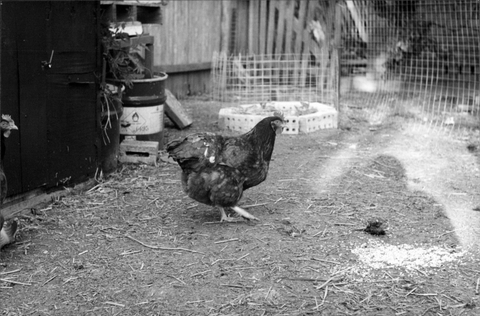The keeping of chooks in suburban backyards has a long history in Australia.
In his book ‘Australia’s Quarter Acre’ Peter Timms says “ ….a visitor from England in 1800, was surprised to find that most Sydney Families, even those of modest means, owned their own home, each on a small plot of land. That was certainly not the case back home.
At the rear, those plots accommodated a variety of outhouses and utility sheds, with perhaps a dog on a chain to guard the back door, a dozen or so fowls for eggs and meat and a pig,” (p32)

He goes on to state – “By the beginning of the 20th century most state governments had banned pigs in urban areas…….The departure from the suburbs of pigs and horses left only chooks and ducks as the only commonly kept productive animals. Poultry ensured a reliable supply of meat and eggs at minimal cost and, in the early days, might well have been the only protein a family had.“ (pp84-85)
In her groundbreaking work “Harvest of the Suburbs” on producing food in the Australian suburban landscape, including chooks, Andrea Gaynor talks about who was keeping poultry in Australian suburbs around 1900: “Keeping livestock and poultry at home also involved costs, although they appear to have had more potential to produce ‘sideline’ cash income than fruit and vegetables. This factor, along with greater mobility (relative to fruit trees) may explain why although livestock and poultry were kept by the middle and upper classes, they appear to have been most popular among working class household.” (p44)
Later on she cites Charles W. Smith, poultry writer for ‘Your Garden’ magazine (a prominent gardening publication of the time focused on practical advice, plant cultivation, and garden design relevant to the Australian climate) as stating in May 1956 – “Properly managed, the back garden can be a self contained food factory” he goes on to state that “backyarders’ should start with early hatched chicks, keeping them for one laying season only by which time the hens will have paid for themselves with eggs they have produced and you can figure on getting your annual profit by cashing them in for meat.” (p155)
She also mentions a resurgence in suburban households keeping chooks (and growing more veggies) in the 1970’s due to the oil shocks resulting reduction in supply and increase in the cost of petrol as well as spiralling inflation. (p162)
Personally, I can remember our neighbours keeping chooks when I was growing up in the southwestern Sydney suburb of Bankstown, back in the early ‘60s. We first got chooks back in the late 1980s after we moved to St Clair, in Sydney’s west suburbs. I had wanted to give them a go for a while but the catalyst was our youngest daughter having food issues, particularly with colours and flavours. This caused us to rethink our diet and since anything but cage eggs were difficult to come across in those days, we started looking into keeping our own. I had been to a conference in Melbourne and met up with a guy from BASF, he showed me a colour card and explained one of his duties was to go and see egg producers. It seems that the cage system was so rough on the chooks, their egg yolks turned out white, so he sold them dye to put in their feed, the more dye, the deeper yellow the yolks were. The colour card helped you work out how much dye to put in to get the shade of yellow you wanted. We haven’t bought caged eggs since.
More recently there have been a couple of impacts on the egg supply which has translated into reduced supply and increased prices for eggs, resulting in more suburbanites looking into keeping chooks. The panic buying caused by covid in the early 2000’s reduced the availability of eggs with the result that people wanted to become more self-sufficient by raising their own backyard chooks.
Also, since last year (2024) Australia has lost 10% of its commercial layers due to efforts to contain bird flu, this in turn has reduced supplies and increased prices. It has not been unusual for us to walk past the egg aisle in our local Woolworths or greengrocer and see that it is empty bereft of eggs. This has not been an issue for us because we keep our own chooks and other suburbanites are starting to show heightened interest in chook keeping in their backyards.
Suburbanites in Australia have always kept chooks. With the continuing stresses on our food supply chains, increasing costs of living and impacts on the industry that supplies commercial eggs, it makes sense to shorten the supply chains for eggs to our own backyards. This can reduce costs, provide fun and entertainment as well as increasing our resilience in the face of the day-to-day stresses of suburban life. Why not start now? (if you haven’t already!)





